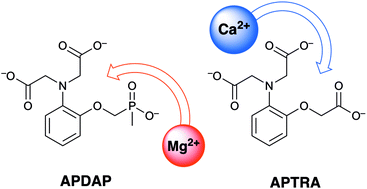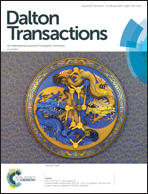Enhanced selectivity for Mg2+ with a phosphinate-based chelate: APDAP versus APTRA†
Abstract
o-Aminophenol-N,N,O-triacetate, known as APTRA, is one of the most well-established ligands for targeting magnesium ions but, like other aminocarboxylate ligands, it binds Ca2+ much more strongly than Mg2+. The synthesis of an O-phosphinate analogue of APTRA is reported here, namely o-aminophenol-N,N-diacetate-O-methylene-methylphosphinate, referred to as APDAP. Metal binding studies monitored using UV-visible spectroscopy show that the affinity of APDAP for Ca2+ is reduced by over two orders of magnitude compared to APTRA, and for Zn2+ by over three orders of magnitude, whereas the affinity for Mg2+ is attenuated to a much lesser extent, by a factor of only about 7. The selectivity towards Mg2+ is thus substantially improved. DFT calculations support the notion that longer P–O and P–C bonds in APDAP (compared to corresponding C–O and C–C bonds in APTRA) favour a larger angle at the metal, an effect that is less unfavourable for smaller ions like Mg2+ than for larger ions such as Ca2+. Derivatives of APDAP can be anticipated that will offer improved sensing of Mg2+ in the presence of Ca2+, in the physiologically important millimolar concentration range.



 Please wait while we load your content...
Please wait while we load your content...